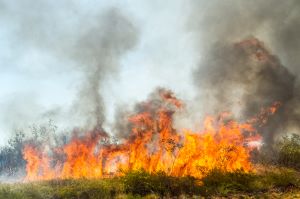
In recent years, there has been an increase in people relocating from urban city centers to more secluded wildland areas across America. Whether it is the appeal of more natural surroundings or the possibility of lower housing costs, the risk of being impacted by a wildfire is increasing. Regardless of how long someone has lived in wildfire prone areas, the need to understand and mitigate against wildfire remains the same.
According to the National Interagency Fire Center (NIFC), this year the U.S. has seen over 37,000 wildfire incidents burning 5,357,0000 acres.
Historically, conversations around protecting homes from wildfire have been primarily focused on defensible space and home hardening. Adding to that subject matter in recent years has been the topic of wildfire suppression systems. Below are some details to help understand these systems to protect against wildfires:
Purpose of wildfire suppression systems. The primary purpose of a wildfire suppression system is to create an environment around the home that is not conducive for wildfire. This is created by activating the system which will spray water over the home and nearby vegetation. The systems will increase the relative humidity near the home and provide resistance to ignition from ember storms.
Where are the sprinkler heads placed and how many are needed? Sprinkler heads will likely be placed on the roof, under eaves, decks as well as the surrounding vegetation if necessary. While a home can be retrofitted with a system, most of the plumbing for the system would be visible. However, including a wildfire suppression system during new construction provides a more aesthetic appearance and ability to “hide” many of the components. The number of heads needed will depend on the size and architecture of the home.
Where does the water come from? Municipal water may be utilized where possible. For remote locations or as a back-up, an alternative source such as a cistern could provide the necessary amount needed.
Is it just water? It depends. Many of the systems on the market currently look for alternative solutions to minimize the amount of water needed and increase the amount of time that the system is effective. Some of these solutions might include fire retardant formulas, class A foams and/or gels.
Activation. Most of the systems on the market provide an activation function on the system inside the home, but the systems also can be activated remotely. Apps are usually available that can provide push notifications on nearby fires, system status notices and other helpful tips. Monitoring services also are typically available for a service fee.
Additional Considerations:
- Cost – The systems vary in price depending on many factors such as size of the home, roof design, plumbing options etc. Per one company, the cost averages between $15,000 and $30,000.
- Location – Is the system beneficial for your location? For example, most systems focus on covering the home and an additional 40-foot radius surrounding it. If living in an urban/town center area, the system would likely be less effective given the proximity to other homes, thereby minimizing the ability to cover the additional 40-foot radius. Put differently, where a home is located in a rural environment determines the effectiveness of providing adequate coverage.
- Home Characteristics – Wildfire suppression systems should supplement the home hardening and defensible space best practices, not replace them. Building fire resistive homes with non-combustible materials and maintaining defensible space on all sides of the home should be prioritized over a wildfire suppression system.
More details on protecting your home from wildfires can be found from your local fire department, your state’s Department of Natural Resources, or other state outdoor agency.
James Milek is a Catastrophe Technical Manager for Chubb Personal Risk Services.
The opinions and positions expressed are the authors’ own and not those of Chubb. The information and/ or data provided herein is for informational purposes only and is not a substitute for professional advice. Insurance coverage is subject to the language of the policies as issued.